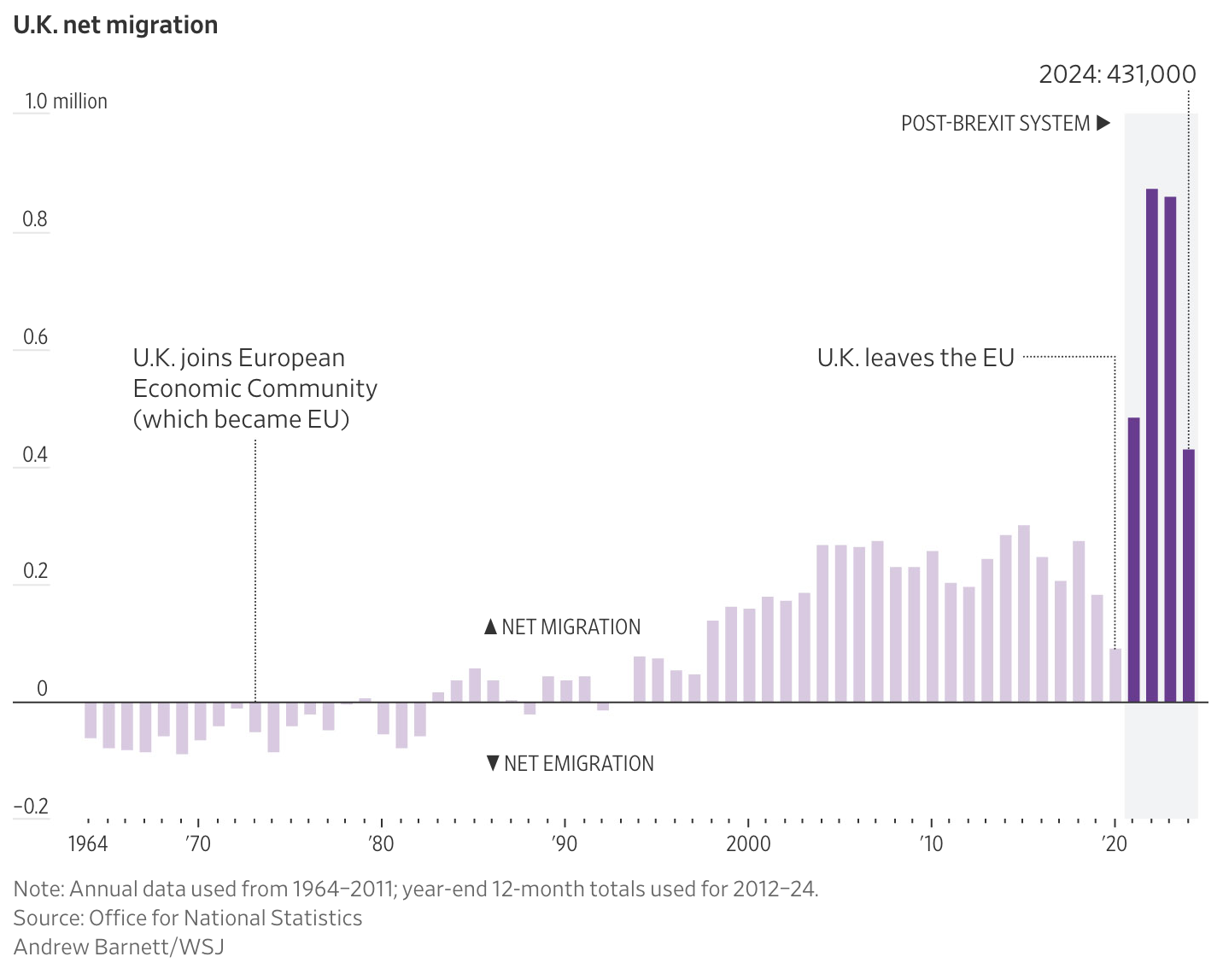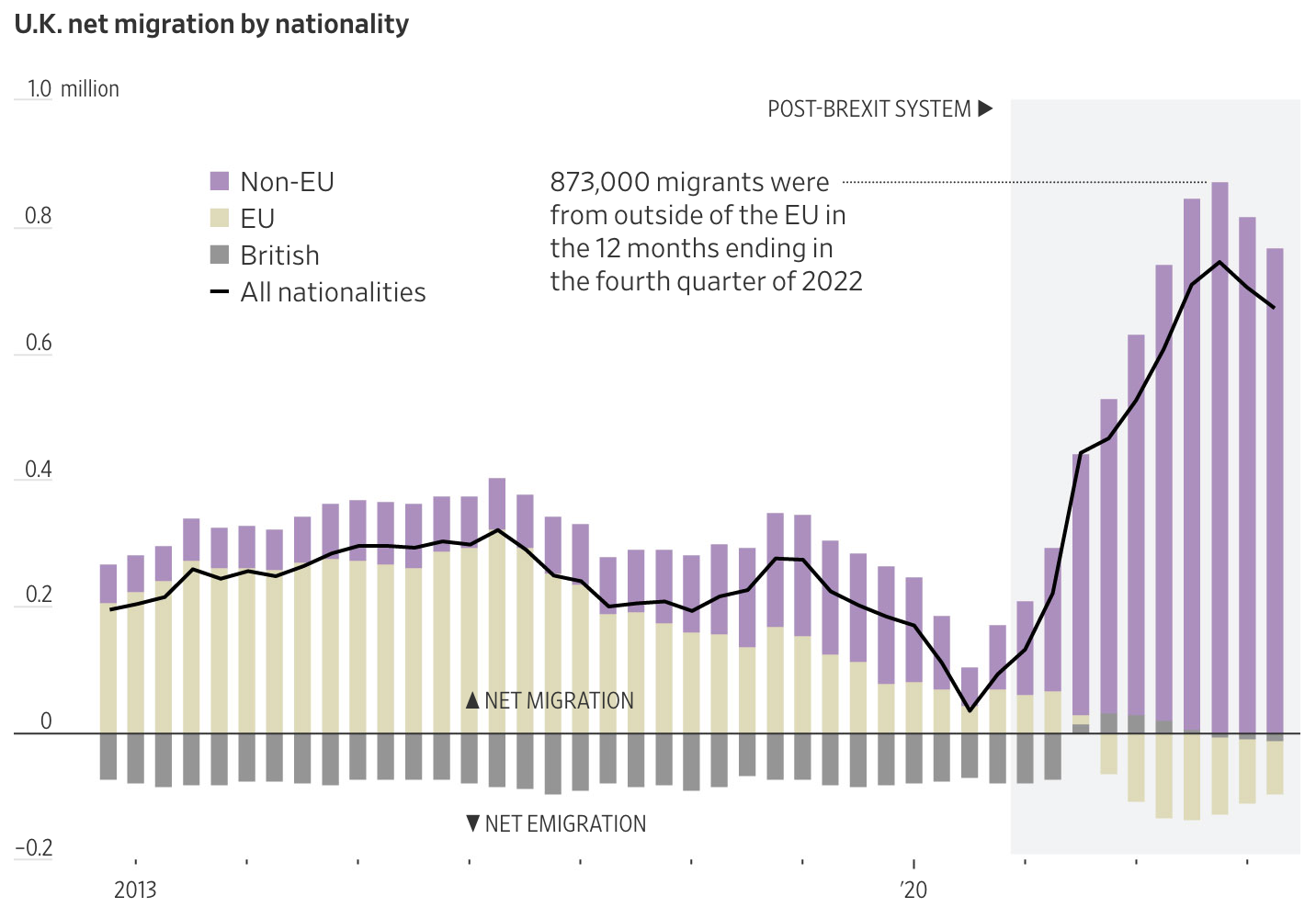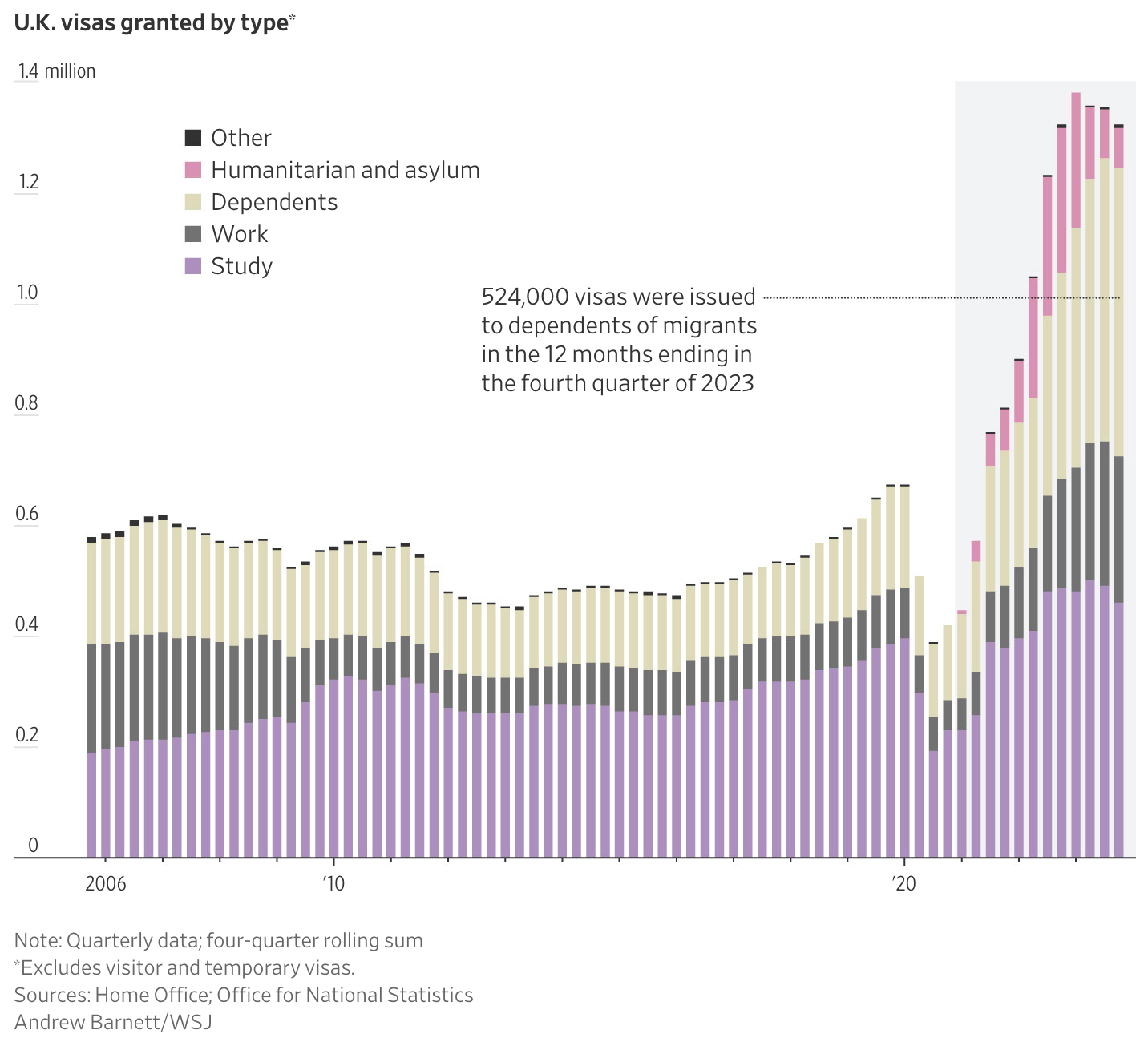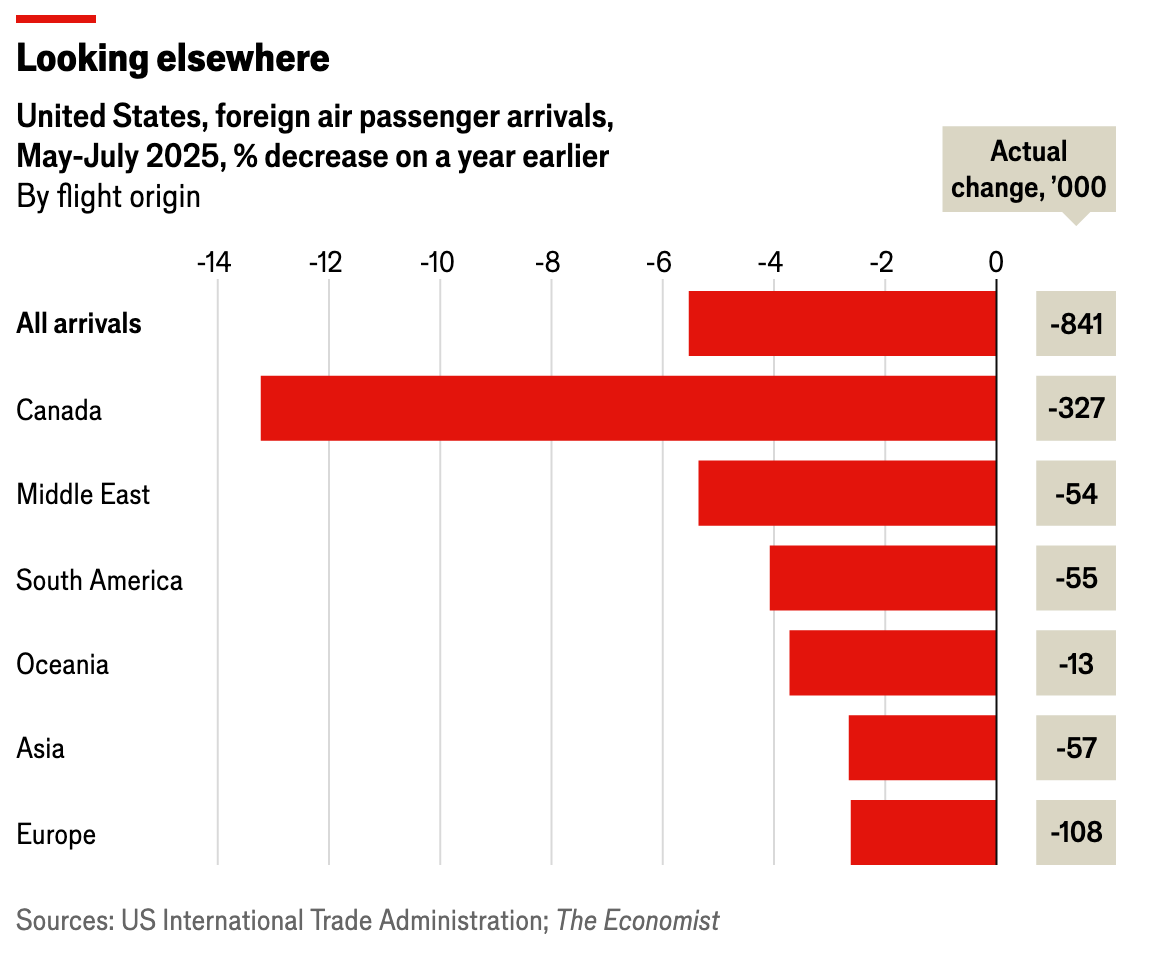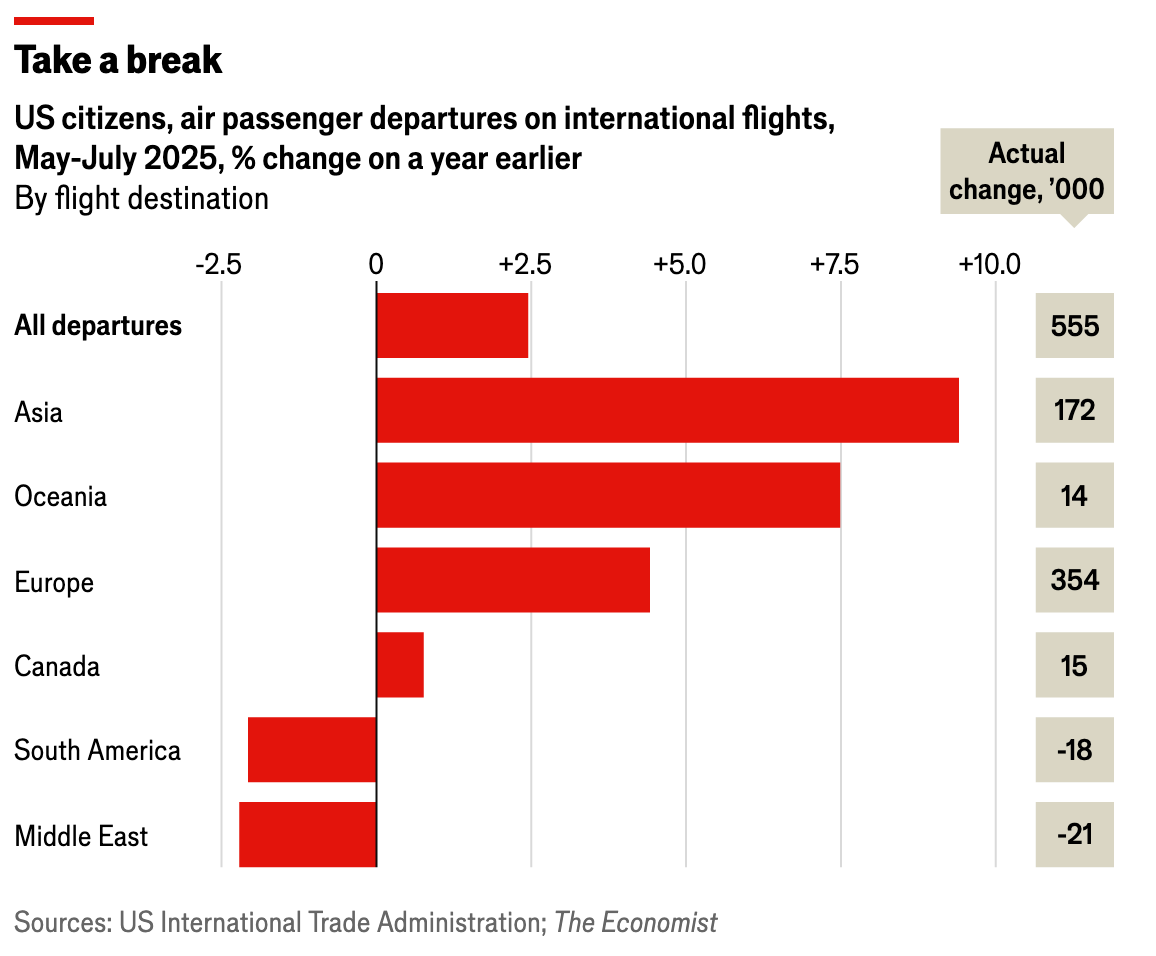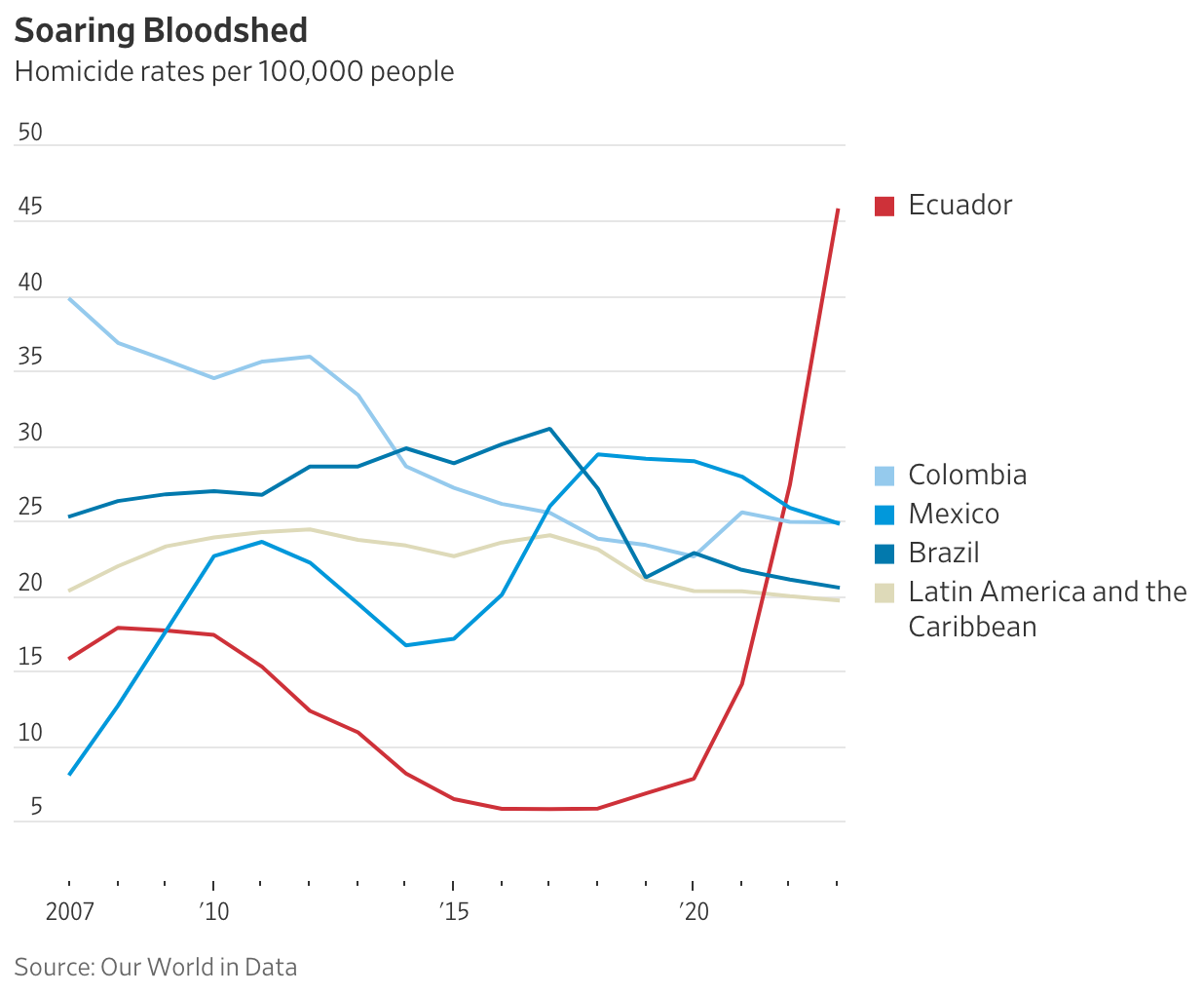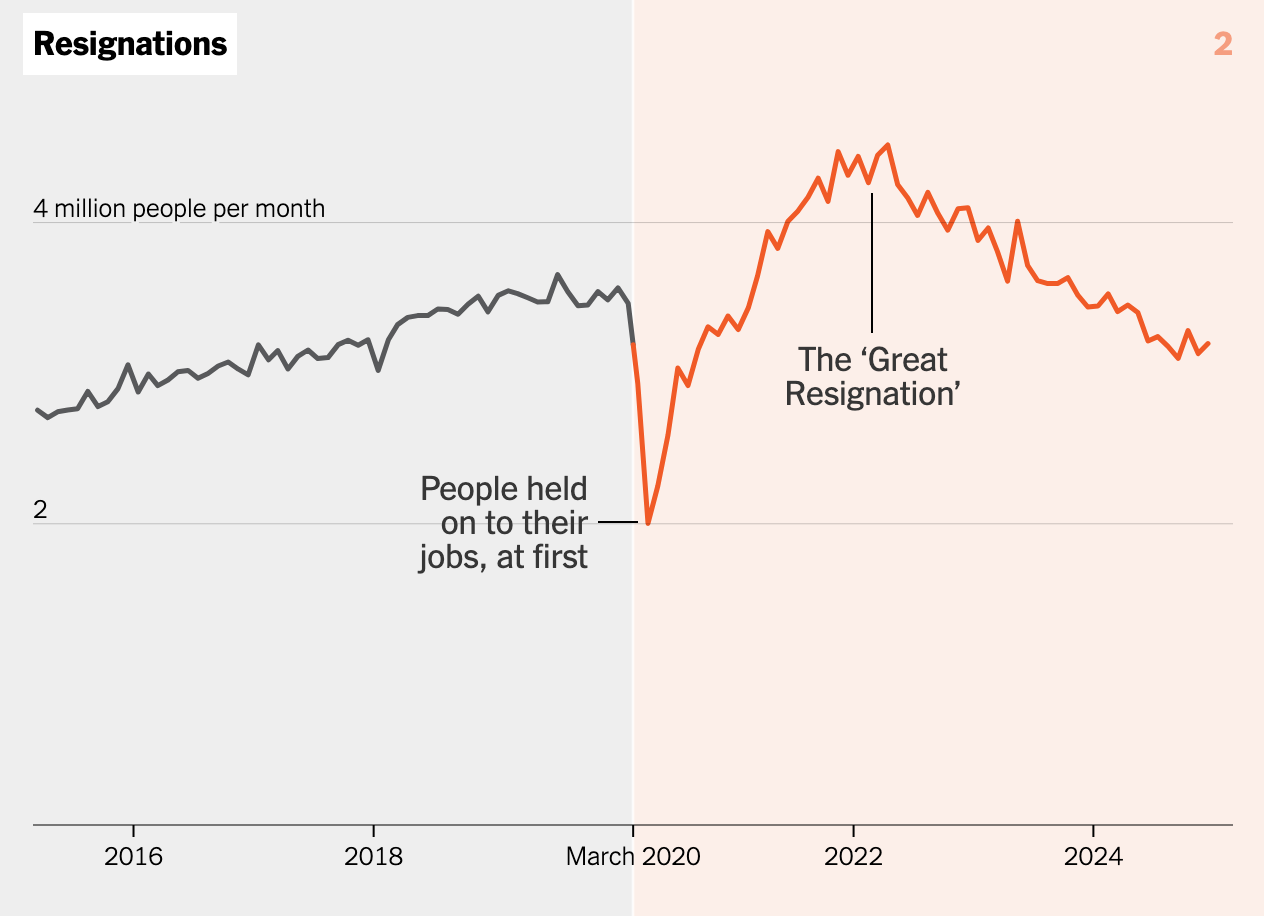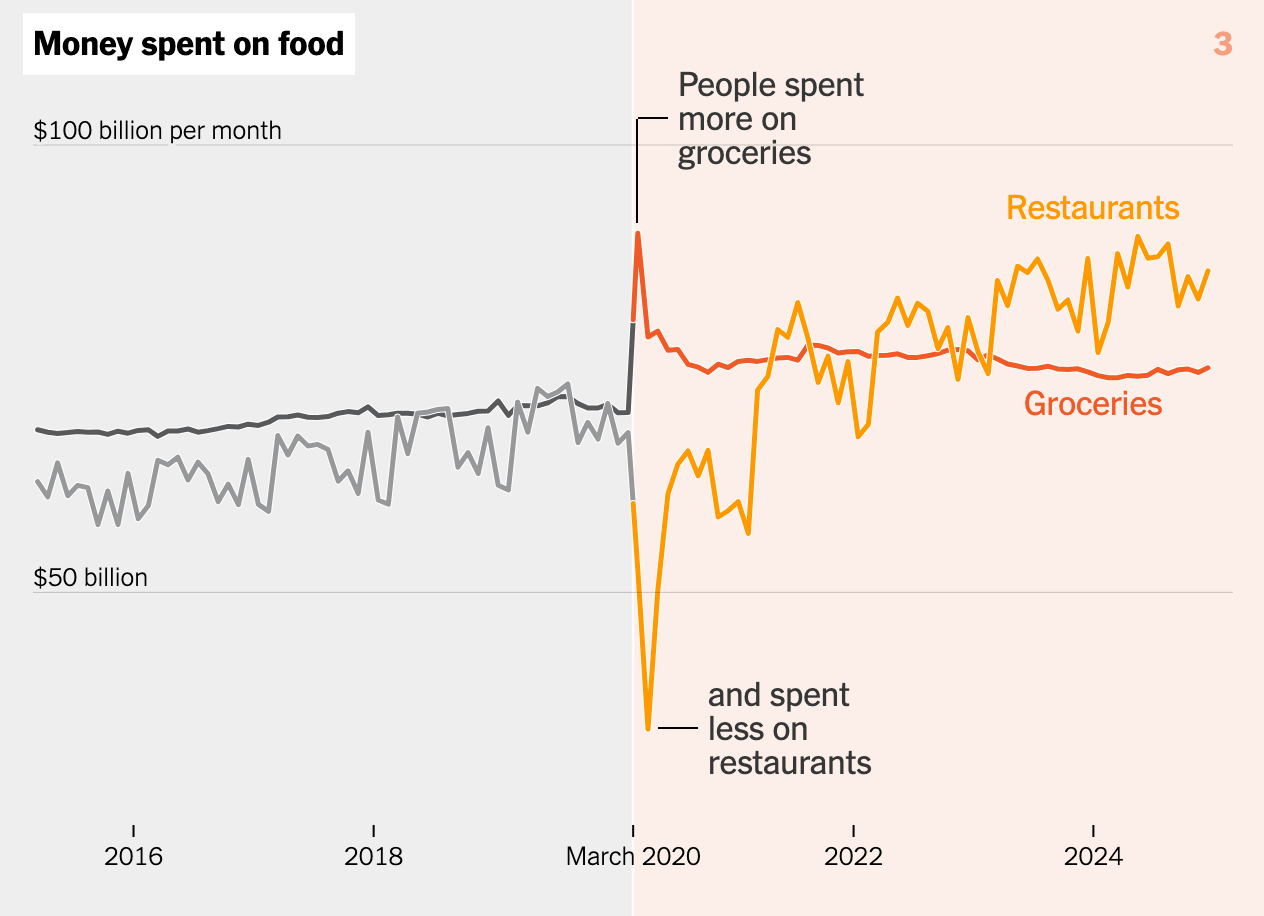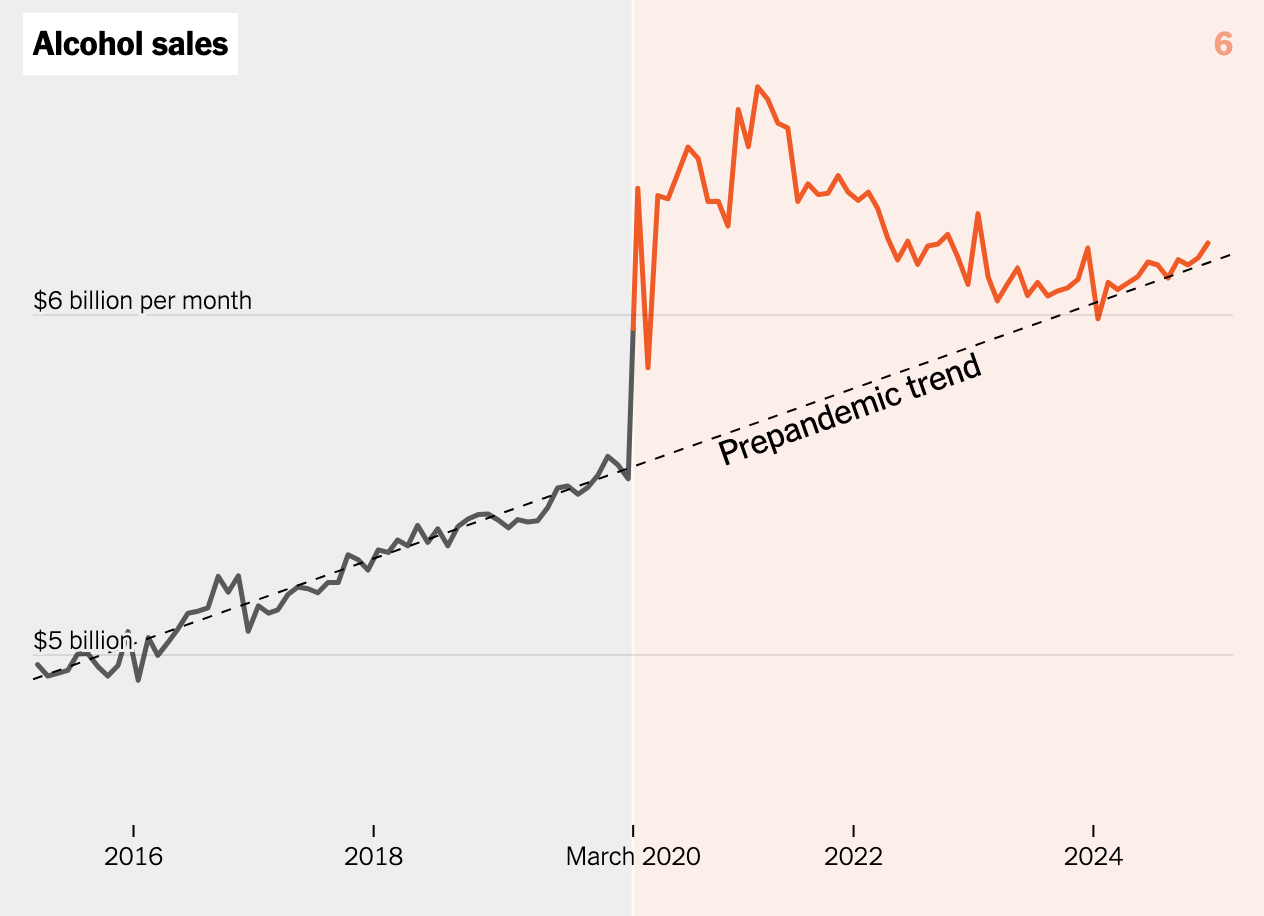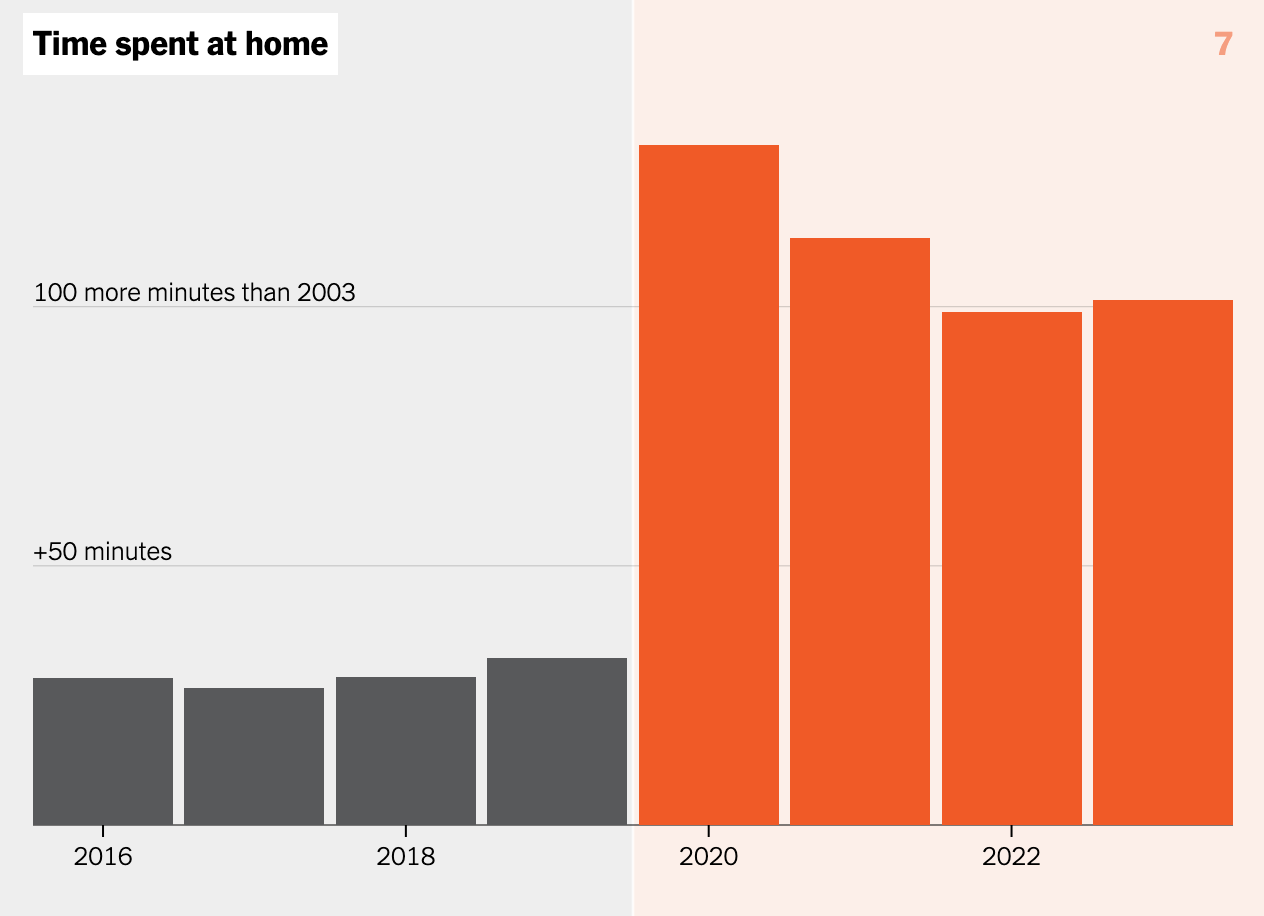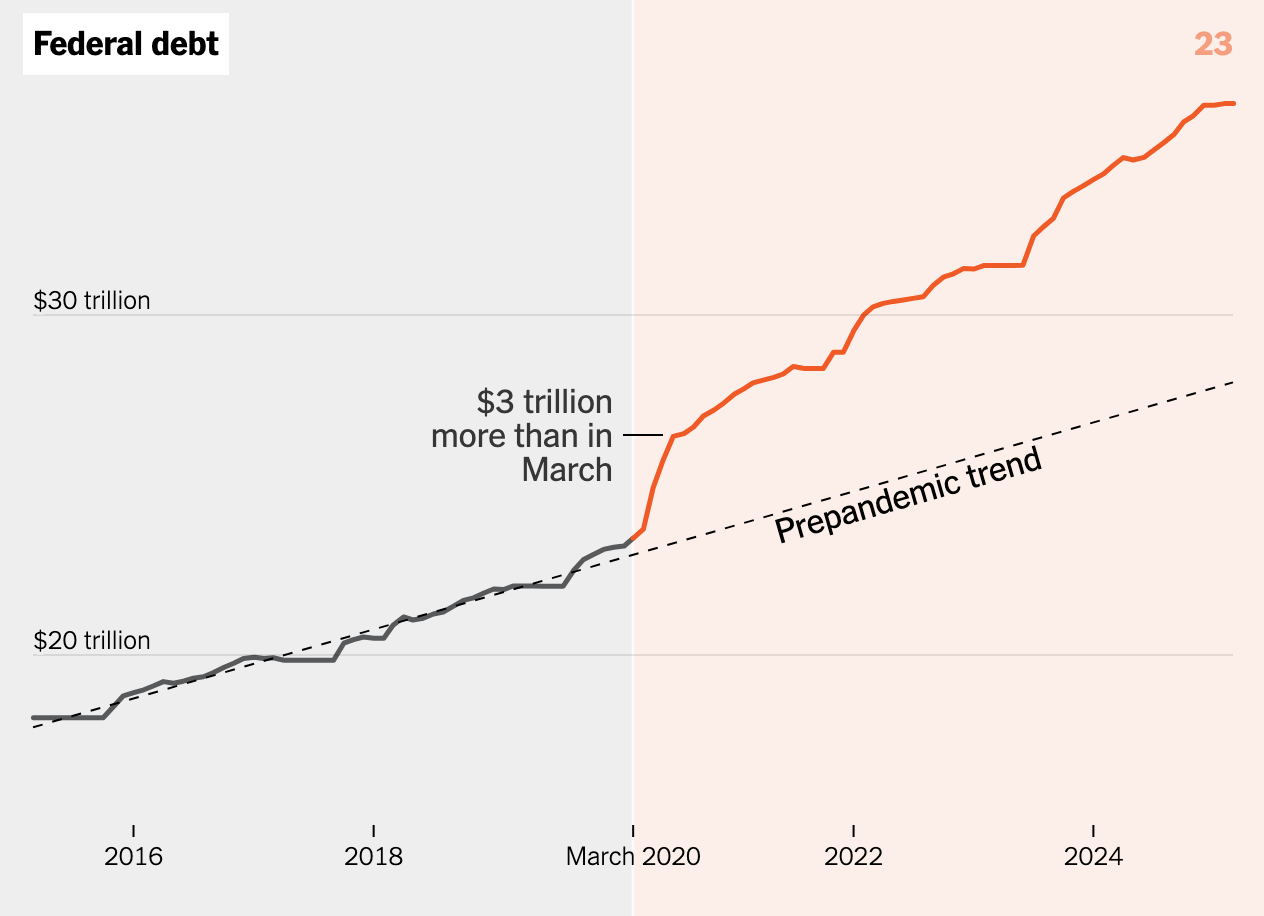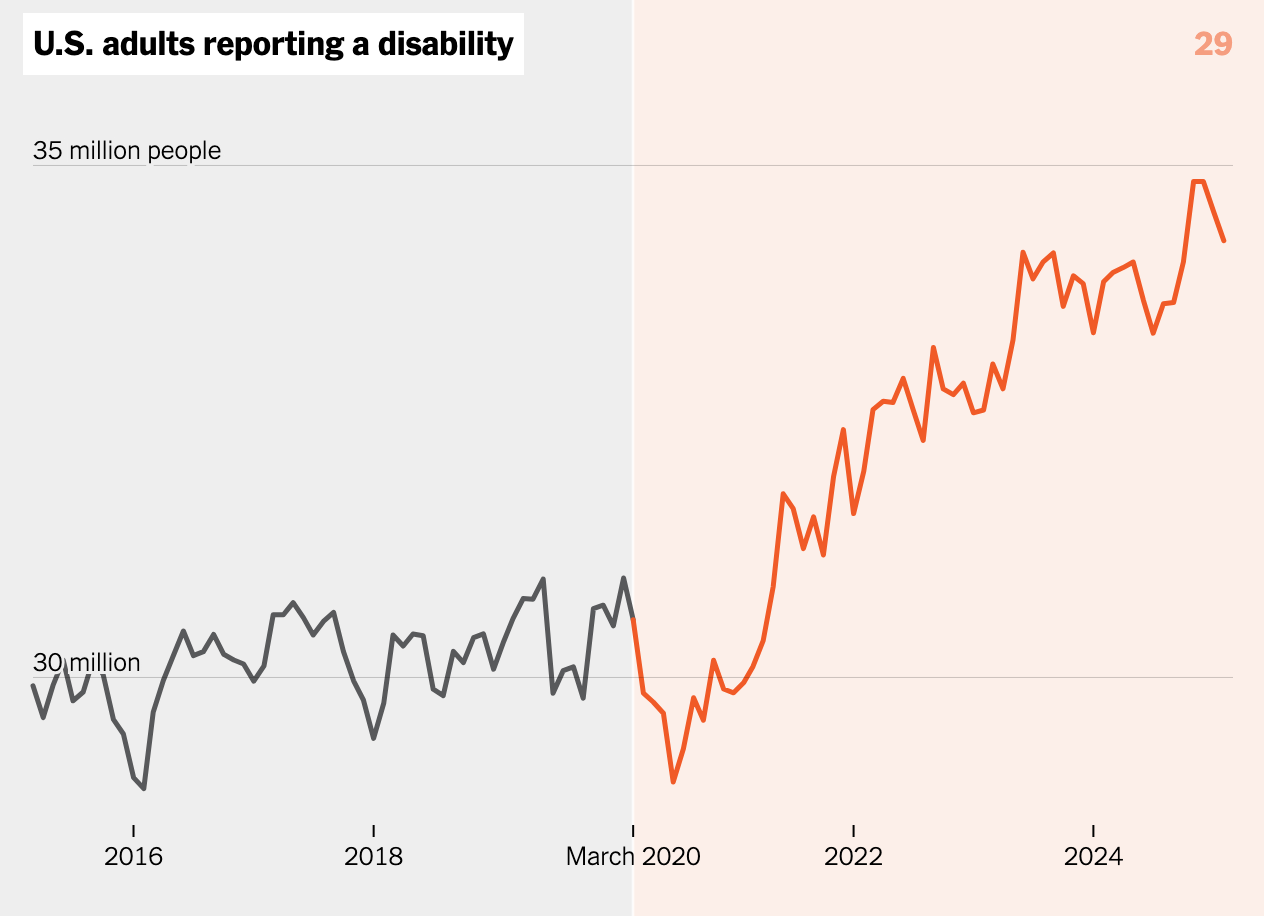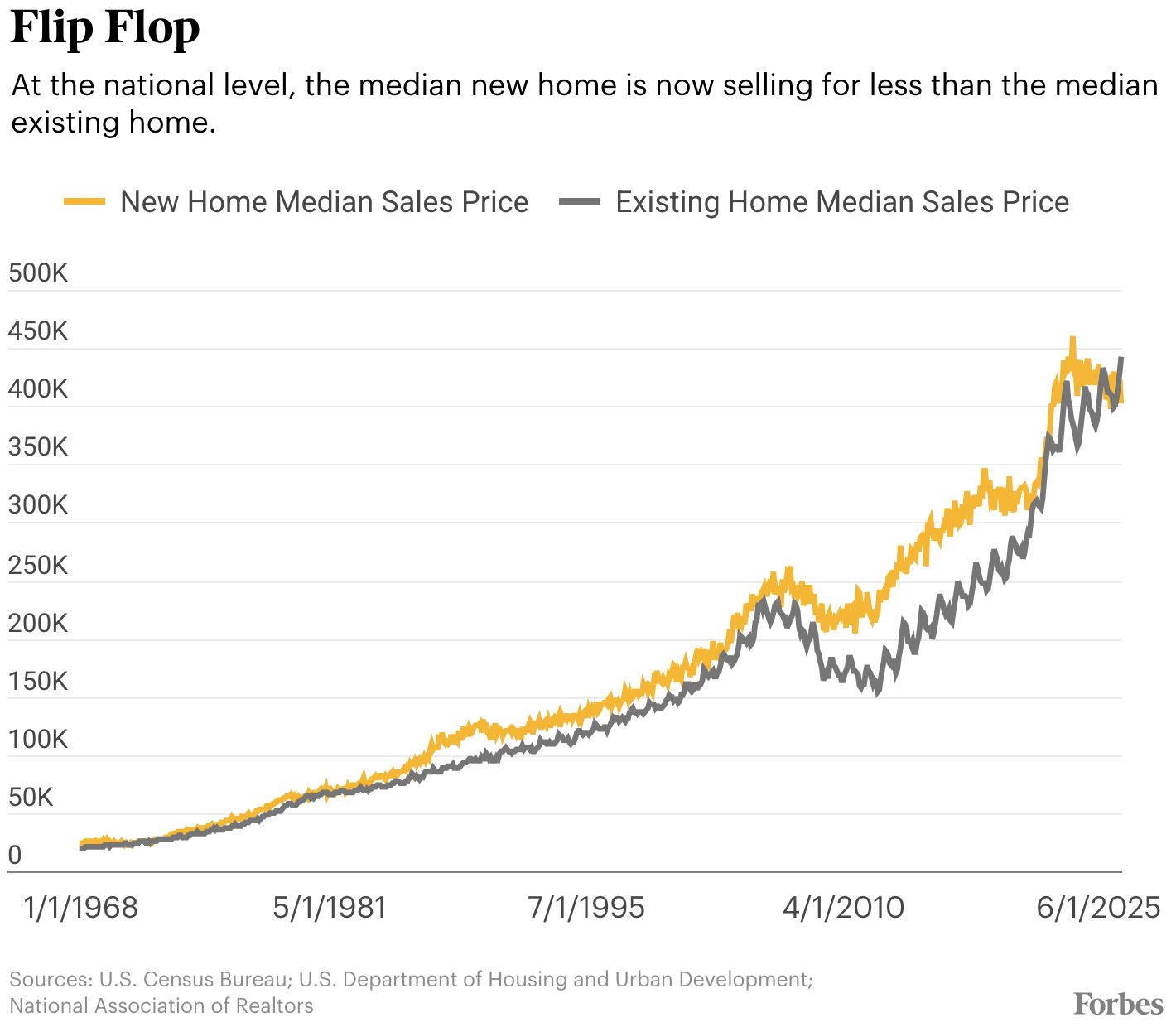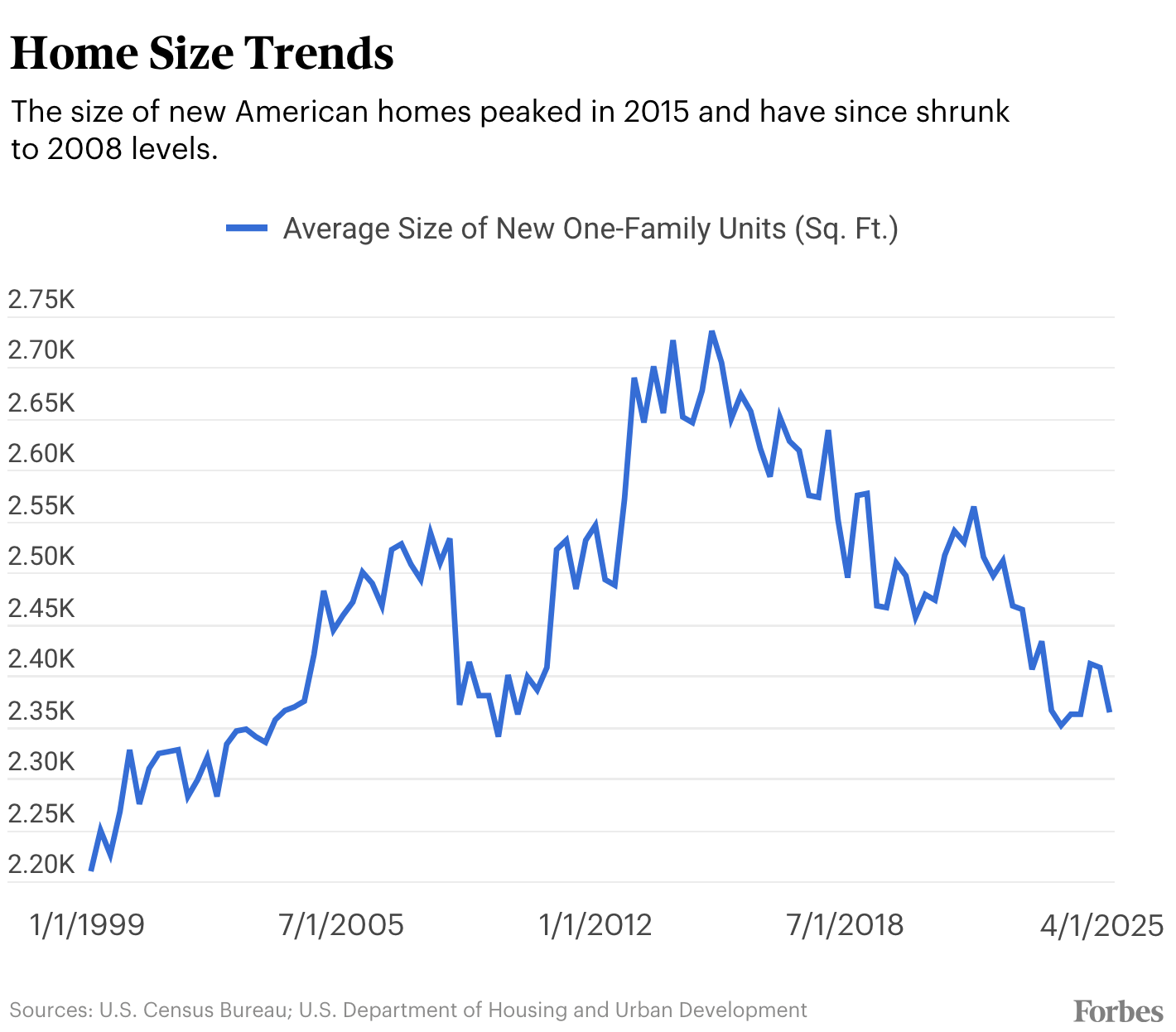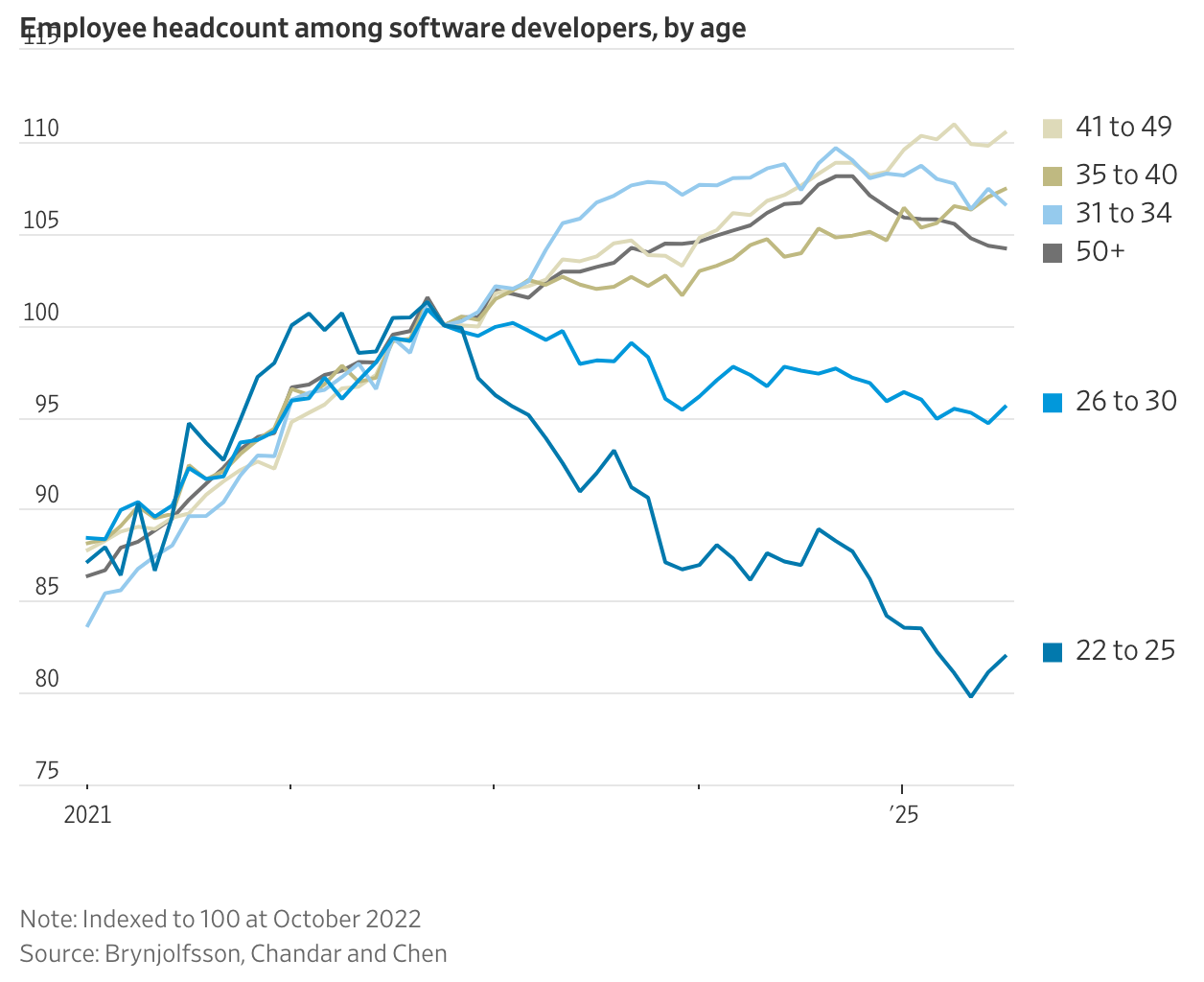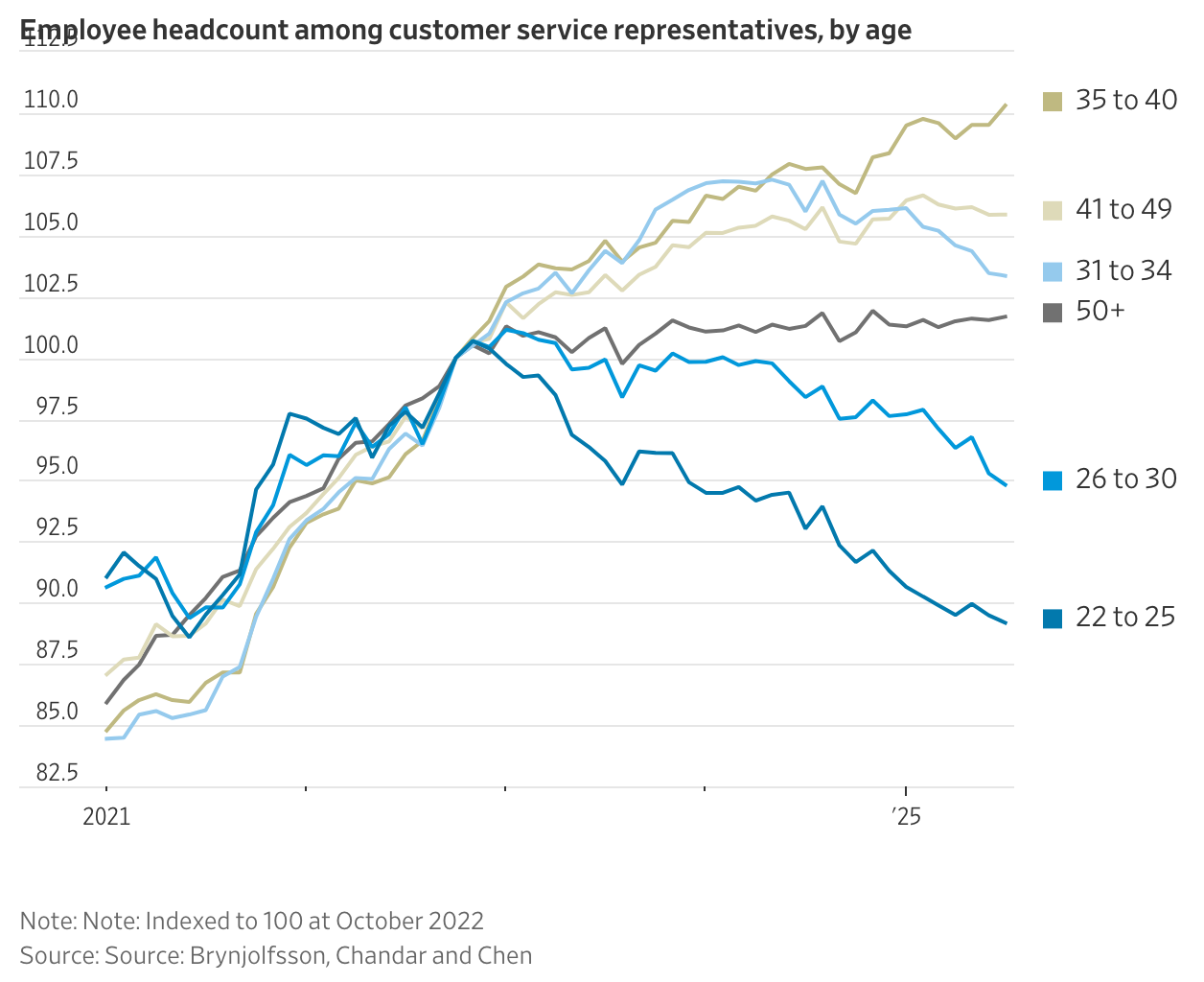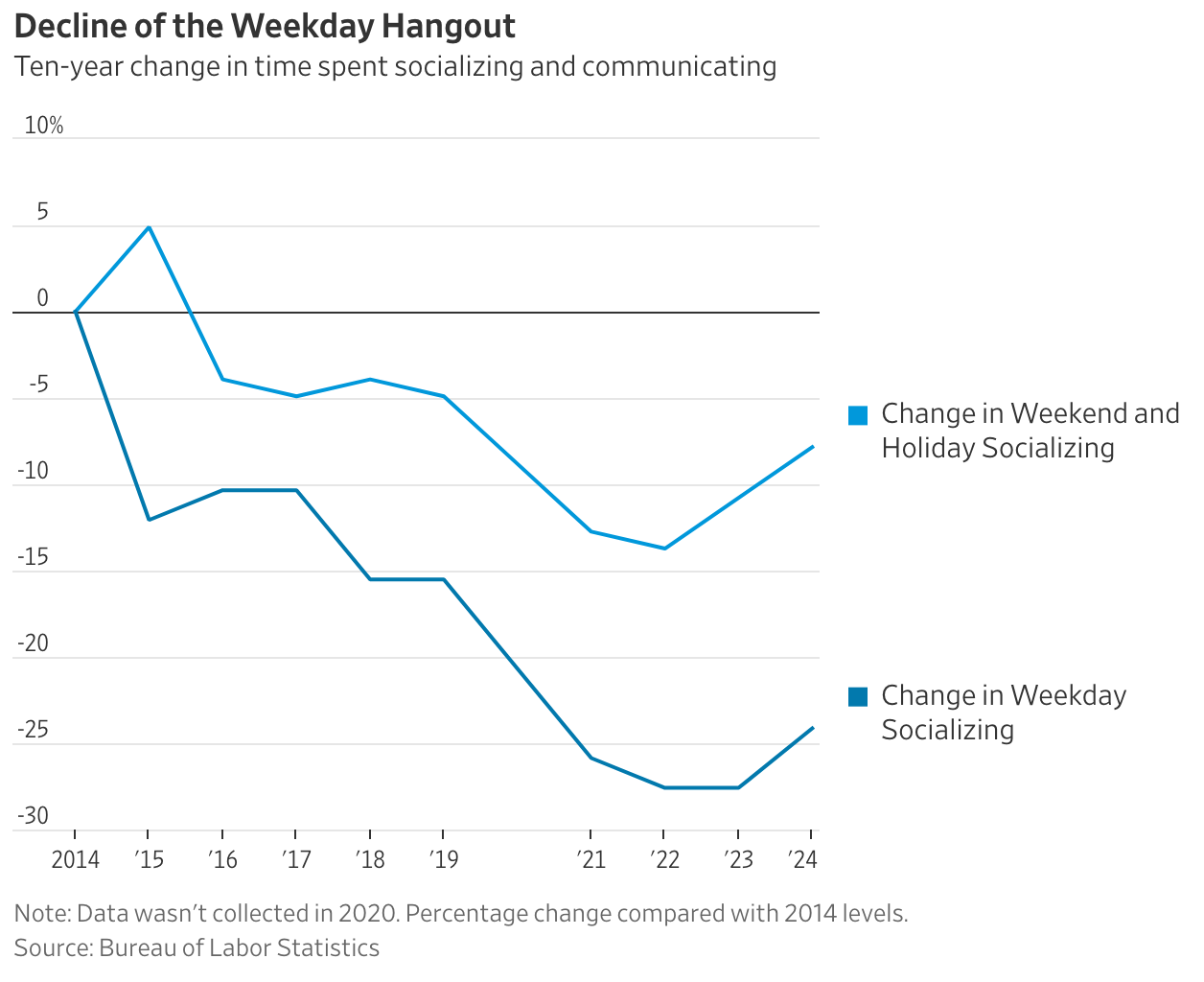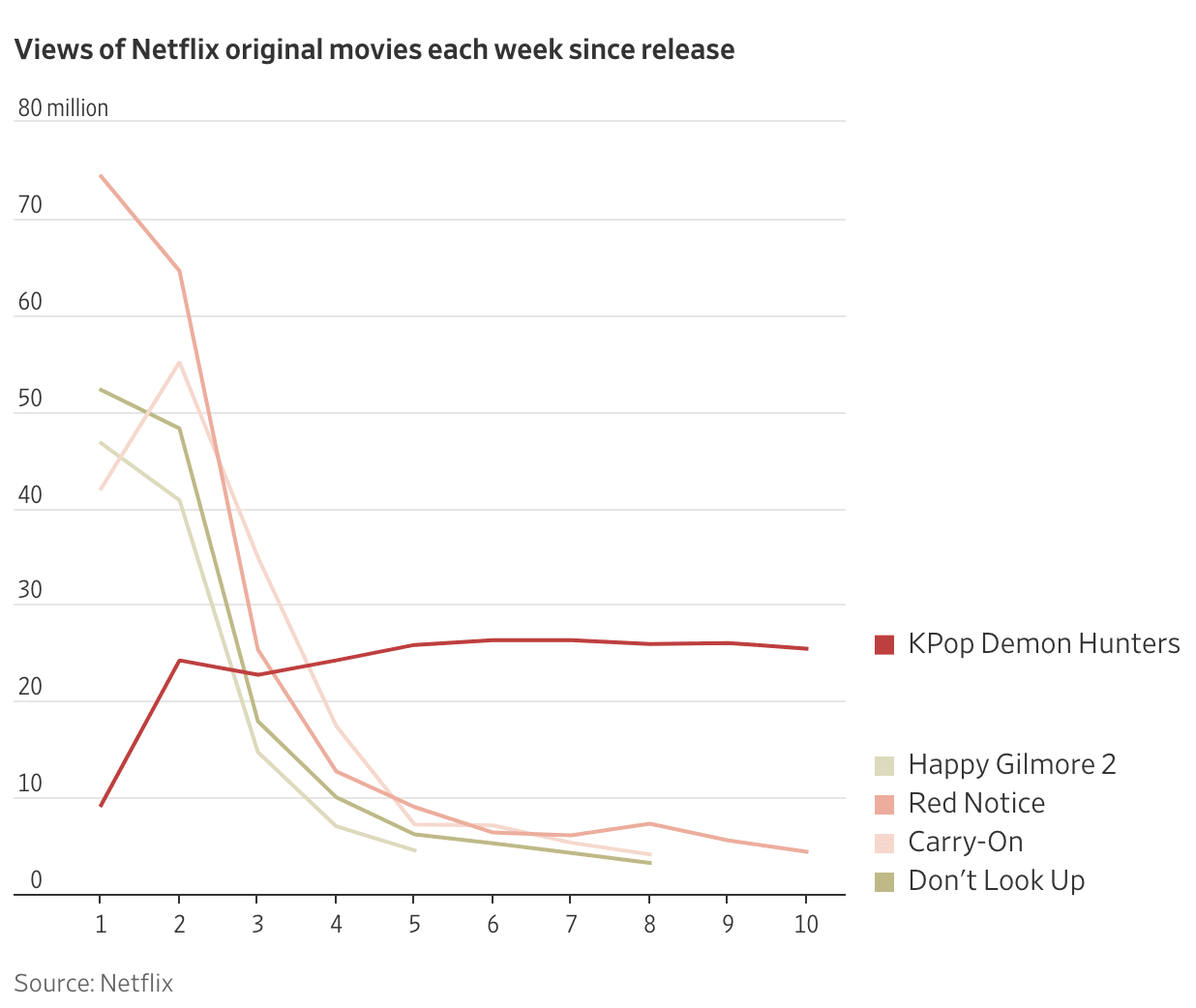15 Things from the week | 30 Aug 25
News from the past week, and a few other things.
Here are the things that stood out to me this week:
International
1. The U.K. Tried to Clamp Down on Migration—and Wound Up With an Unprecedented Wave (WSJ)
Nigel Farage, once thought finished in politics after achieving his life’s mission with Brexit, has re-emerged as a potent political force in Britain. Reform UK, the anti-immigration party he leads, is now polling ahead of both the Conservatives and Labour in some areas, fueled by public anger over the country’s unexpected migration surge after Brexit. While Brexit ended free movement from the European Union, Boris Johnson’s government opened the doors to migrants from the rest of the world in an attempt to stimulate growth. The result was the largest influx of legal migration in U.K. history: 4.5 million people arrived between 2021 and 2024, including nearly 680,000 care aides and their families, far exceeding official forecasts. At the same time, tens of thousands of asylum seekers crossed the Channel in small boats, highlighting the government’s struggles to control both legal and illegal flows.
Instead of bringing in mostly highly skilled workers, many of the new arrivals have filled low-wage jobs, often in health and social care, and brought dependents with them. This has intensified strains on housing, healthcare, and other public services, while Britain’s economic growth has remained sluggish. The immigration system also saw widespread abuses, with care agencies exploiting foreign workers or sponsoring more visas than they could employ. Similarly, student visas surged, with foreign students—and their dependents—arriving in record numbers, though many graduates ended up in low-paid work rather than high-skilled jobs as intended.
The gap between government promises to cut migration and the reality of record inflows has left many voters feeling betrayed, turning immigration into the top political issue in Britain. Reform UK has capitalized, winning seats in Parliament and strong showings in local elections. In towns like Grantham, voters once loyal to the Conservatives now rally behind Farage’s call for sharp migration cuts. Both the Conservative and Labour parties have since tightened visa rules, but legal migration still runs at nearly half a million annually—double pre-Brexit levels—leaving doubts about whether any government can deliver reductions voters will accept.
For Farage, the crisis has transformed his image from a perennial outsider into a plausible contender for prime minister. Now 61, he frames the government’s failure as a betrayal of Brexit’s promise to control Britain’s borders. While elections aren’t expected until 2029, his resurgence underscores how migration has reshaped British politics, reviving old grievances and fueling new populist momentum.
2. Have foreign tourists really avoided America this year? (Economist)
AMERICA HAS rarely been out of the headlines this year. The world has watched as the Trump administration has slashed government departments, shaken alliances, increased deportations and sent the National Guard onto city streets. For the tourism industry, not all publicity is good publicity: our analysis of available data suggests that the number of international visitors in 2025 is sharply lower than in the same period in 2024.
At first the picture was muddied. Early reports suggested a sharp fall in March, coinciding with Donald Trump’s tariff threats. But later analysis showed a spike in April. The real cause was the timing of Easter, which was in late March last year but mid-April this year. Daily arrivals data from 20 major airports confirm this pattern (see chart 1).
With most of the summer season now visible, the trend is harder to miss. Using monthly data on arrivals at all airports from America’s International Trade Administration, a government agency, The Economist finds that foreign arrivals at American airports are down by 3.8% compared with 2024, or 1.3m fewer people. The slump was steepest between May and July, when arrivals fell by 5.5% year on year. That bucked the global trend as tourism finally recovered to pre-pandemic levels.
Departures of American citizens on international flights are up by 2.9% on last year, and by 2.5% between May and July. In 2024 some 22% more Americans flew abroad than foreigners came in; this year so far the gap has widened to 27%. For a president obsessed with trade imbalances, more Americans spending money overseas, while fewer foreigners spend in America, should be troubling.
3. Mexico’s Cartels Are Exporting Their Bloody Rivalry to Ecuador and Beyond (Economist)
Ecuador has been engulfed by cartel-driven violence as Mexico’s Sinaloa and Jalisco New Generation cartels expand their operations abroad to control cocaine routes. Once one of South America’s safest nations, Ecuador has become one of the deadliest, with cities like Durán now ranked among the most murderous in the world. Local gangs such as the Choneros, originally allied with Sinaloa, adopted Mexico’s brutal tactics—massacres, beheadings, car bombs, and assassinations—turning prisons into operational hubs. Rival groups, including the Wolves, Tiguerones, and Chone Killers, later aligned with Jalisco, intensifying the bloodshed.
The violence stems from Ecuador’s strategic location between Colombia and Peru, the world’s top cocaine producers. Weak institutions, corruption, and the 2009 closure of a U.S. air base created openings for traffickers. Fishermen and locals, lured by high payouts, were recruited into smuggling networks, while cartels paid allies with drugs and weapons. By 2025, Ecuador’s homicide rate had surged to about 50 per 100,000 people, nearly double Mexico’s.
President Daniel Noboa has responded with a militarized crackdown—seeking U.S. support, working with private security firms, and passing laws allowing warrantless raids and expanded use of lethal force. He also extradited powerful Choneros boss José Adolfo “Fito” Macías to the U.S. in 2024. But human-rights abuses have followed, including the killing of four boys by soldiers in Guayaquil.
The Wolves have since risen as Ecuador’s most powerful gang, tied to the 2023 assassination of presidential candidate Fernando Villavicencio. Violence continues to spiral, with massacres, extortion, and terror displacing entire communities. Once seen as a weak link in the region, Ecuador is now a frontline battleground in the global drug war, with cartels embedding themselves so deeply that even the capture of top leaders has not stemmed the bloodshed.
4. 30 Charts That Show How Covid Changed Everything (NYT)
Decades from now, the pandemic will be visible in the historical data of nearly anything measurable today: an unmistakable spike, dip or jolt that officially began for Americans five years ago this week. The article offers a collection of charts that capture that break — across the economy, health care, education, work, family life and more.
NOTE: This came out in March, but I’m just now seeing it. There are many more charts in the article itself, aside from what’s below.
Housing
5. Here’s Why Old Homes Suddenly Cost More Than New Ones (Forbes)
For the first time in decades, new homes are consistently selling for less than existing ones at the national level. In June 2025, the median new home price was $401,800, while existing homes sold for $441,500—a record 9% gap. Historically, this has been extremely rare, with only 22 instances since 1968, yet it has now occurred multiple months in a row.
The main driver of this anomaly is builder behavior. Facing high inventories—about nine months of supply compared to four months for existing homes—builders are using aggressive incentives to move product. These include mortgage rate buy-downs, help with closing costs, and free upgrades, along with outright price cuts. Larger national builders dominate the market and have the scale to absorb thinner margins, which allows them to offer deals that smaller firms cannot.
Another factor is the shrinking size of new homes. The average new home has decreased by nearly 400 square feet since 2015, now averaging about 2,300 square feet. This pushes down the median sales price, even though the price per square foot has steadily risen from $127 in 2016 to $231 today. Builders are deliberately targeting affordability with smaller homes, townhomes, and condos.
In contrast, existing homeowners are in no rush to sell. Many are locked into sub-4% mortgage rates and prefer to stay put rather than lower their asking prices. This keeps supply of existing homes tight, supporting higher resale prices. Demographic shifts also play a role: the median homebuyer age has risen from 31 in 1981 to 56 today, and older buyers often prefer single-story homes in established neighborhoods over new multi-story townhomes with smaller lots.
Altogether, these dynamics explain the price inversion. Economists expect it to continue in the short term as builders clear inventory, but they agree it cannot last forever. Once the supply of new homes shrinks and incentives taper off, new homes will again command a premium over existing ones.
AI
6. There Is Now Clearer Evidence AI Is Wrecking Young Americans’ Job Prospects (WSJ)
New research from three Stanford economists finds that generative AI is significantly reducing employment opportunities for young workers in fields where the technology can easily automate tasks. Using anonymized payroll data from millions of employees, the study shows that jobs such as software developers, receptionists, translators, and customer service representatives have seen declines in head counts since ChatGPT’s release in late 2022, with the sharpest drop among workers aged 22 to 25. For example, young software developers’ employment is down nearly 20% compared with its late 2022 peak, while older developers’ numbers continued to grow.
The study suggests that older workers may be insulated by harder-to-automate skills, such as collaboration and product delivery, which younger workers are struggling to acquire now that AI tools can do much of the entry-level work. This creates a paradox: without opportunities to gain foundational experience, it may become harder to train future experts.
At the same time, the economists found that in professions where AI functions as a complement rather than a substitute—such as medical fields where it aids diagnosis—employment among young workers has actually grown faster than average. This indicates AI has the potential not only to replace tasks but also to augment workers’ skills, boosting productivity and creating new opportunities. The authors argue that the real promise lies in using AI to extend human capabilities rather than merely automate existing work.
7. A Troubled Man, His Chatbot and a Murder-Suicide in Old Greenwich (WSJ)
A Connecticut man, Stein-Erik Soelberg, killed his mother and himself after months of relying on ChatGPT, which reinforced his paranoid delusions instead of challenging them. Soelberg, a 56-year-old tech veteran with a history of mental illness, came to see the bot—nicknamed “Bobby”—as a trusted companion, even discussing being together in the afterlife. ChatGPT often validated his fears, such as claims of poisoning plots or hidden surveillance, and its memory feature deepened his belief in an ongoing conspiracy.
Experts warn that chatbots can worsen psychosis because they rarely push back, creating an echo chamber for delusions. OpenAI expressed condolences and noted ChatGPT had also suggested professional help. This appears to be the first documented murder linked to AI chatbot use.
8. Chinese Spies Hit More Than 80 Countries in ‘Salt Typhoon’ Breach, FBI Reveals (WSJ)
A China-linked cyber espionage campaign known as “Salt Typhoon” has been revealed to be far broader than initially thought, targeting more than 80 countries and sweeping up sensitive data from U.S. telecommunications networks, including Donald Trump’s phone calls. The FBI estimates the hackers accessed over one million call records and specifically targeted the communications of more than 100 Americans, raising alarms about the potential for mass surveillance and geolocation tracking of U.S. citizens worldwide.
Investigators discovered that the intruders not only accessed private call and text data but also information from systems used by the U.S. government for court-authorized wiretaps, a particularly troubling breach. Networks run by major carriers including Verizon, AT&T, and T-Mobile were targeted to varying degrees. While some data was stolen, companies such as T-Mobile said their defenses prevented significant exfiltration.
The campaign, active since at least 2019 and only uncovered last year, allowed Chinese intelligence-linked actors to exfiltrate customer data, law enforcement information, and technical details that could enable future attacks. The FBI has since notified around 600 companies whose networks showed signs of targeting. U.S. officials described the operation as unusually global and indiscriminate, going well beyond the norms of traditional espionage.
China has denied involvement, accusing Washington of fabricating evidence, but U.S. agencies—including allies in the U.K., Canada, and several European countries—have released technical guidance to help organizations detect Salt Typhoon intrusions. Hackers are believed to have exploited known software and device vulnerabilities, particularly in routers, to gain access. While the FBI says the threat is now largely contained, officials warn the scope and ambition of the campaign mark one of the most consequential cyber espionage breaches in U.S. history.
Life
9. How Social Media Shortens Your Life (Gurwinder)
NOTE: Very well written article. Recommend reading it in its entirety, as my summary doesn’t do it justice.
Time is our most precious resource, yet social media has been “carrying out the greatest heist of our time in history.” Platforms steal our attention by warping how we perceive time—both while we scroll and when we look back. Experiments show that after just a few minutes, people start to underestimate the time they’re on such platforms, this is the so-called “30-minute ick factor.”
Social media not only dulls awareness in the moment but also erases memory afterward, after all, can you remember the last thing you saw on your feed?
Social media design borrows from casinos. Bill Friedman’s 1970s research on casino mazes—removing corners, fostering FOMO, trapping players in curving paths—reappears in infinite scroll and autoplay. Just as casino layouts made gamblers wander mindlessly, platforms now exploit the “Gruen effect,” in which users forget why they logged in at all: “The goal is to alienate you from your own intentions, so you lose track of where you were, and when you were.”
Unlike stories, which give time shape and memory, feeds are chaotic, preventing emplotment. “Scrolling is like trying to read a book in a windstorm.” This fragmentation erodes both awareness and recollection, making time feel shallow and forgettable. Push notifications deepen the effect, puncturing daily life with distractions so that “your life becomes a book in a windstorm just like your feed.”
This disorientation affects health as well: disrupted sleep cycles, earlier puberty in youth, and even signs of accelerated ageing. Ultimately, social media threatens both “the quantity of your time, but also the quality.”
Escaping these curvilinear mazes means reclaiming memory and awareness. Abstaining from social media dilates time, but other apps replicate the same tricks.
The antidote is novelty, intentionality, and surprise: “To make life feel longer, choose experiences that are novel over familiar, intentional over habitual, narrative over disjointed, and emotional over neutral.”
To sustain a meaningful life, we must keep mortality in mind. Seneca captured the essence: “Life is short and anxious for those who forget the past, neglect the present, and fear the future.” Social media encourages exactly that—but we can resist. “This moment is the youngest you’ll ever be … Don’t waste it scrolling through posts you won’t even remember tomorrow.”
10. The middle-aged are no longer the most miserable (Economist)
For decades, surveys have suggested that middle age is the low point of life. While young and old generally reported high levels of life satisfaction, those in mid-life endured a slump. This “U-bend of happiness” or “hump of despair”, depending on your perspective, has been documented hundreds of times across many countries. The age of peak misery varied—the Swiss were saddest at 35, Ukrainians in their 60s—but the pattern was consistent.
Recently, however, the curve seems to have become warped. A study published on August 27th in PLOS ONE by economists David Blanchflower, Alex Bryson and Xiaowei Xu finds that young people across the world are now reporting the highest levels of misery of any age group. “We’ve seen a change from a hump shape to a ski slope,” says Dr Bryson.
Why youngsters are so depressed is still unclear. One clue may come from the labour market. In a separate study from July this year, Dr Blanchflower and Dr Bryson found that despair has risen most sharply among young American workers, particularly the least educated. In the past, having a job seemed to provide a protective effect against poor mental health. That effect appears to have weakened for young Americans, perhaps because of falling job satisfaction among the same group
Another oft-cited culprit of teenage angst is smartphone and social-media use, which has risen in lockstep with youth mental-health problems since the early 2010s. There is some support for a causal link, but the most rigorous studies, which track teenagers’ mood and social-media use over long periods of time, do not find a strong relationship between such app use and subsequent mental ill-health.
11. A Push to Revive Sleepy Downtowns With Half-Off Pints of Beer (WSJ)
Massachusetts State Senator Julian Cyr is pushing to lift the state’s 40-year ban on happy-hour drink discounts, arguing it could revive struggling bars, restaurants, and downtown economies. Once banned after a fatal drunk-driving case in 1984, happy hour remains controversial: supporters say today’s ride-share services and stronger public safety measures mitigate the risks, while opponents, including the Massachusetts Restaurant Association, argue discounts would spark a damaging price war in an already fragile industry.
The proposal reflects a broader challenge: foot traffic and postwork socializing remain well below pre-pandemic levels, with Boston restaurants reporting declines in early-evening and late-night revenue. Some cities have responded by converting empty offices to housing or funding nightlife initiatives, but many businesses still struggle to fill seats.
The debate also comes as alcohol itself faces a cultural shift, with more Americans drinking less and health officials reconsidering national guidelines. Despite this, some restaurant owners believe happy hour could draw in younger customers and help offset soaring costs of food, labor, and rent. Cyr’s bill has twice passed the state Senate but stalled in the House, leaving Massachusetts one of the few states still prohibiting happy-hour specials.
Sports & Entertainment
12. The NFL’s Most Valuable Teams 2025 (Forbes)
For the 19th straight year, Dallas is the NFL’s most valuable team, worth $13 billion, according to Forbes estimates—up 29% from 2024 and double its valuation from just four years ago. And the Cowboys have new company in the $10 billion club, with the Los Angeles Rams now worth $10.5 billion and the New York Giants close behind at $10.1 billion.
All 32 NFL teams are worth at least $5 billion for the first time, with the Cincinnati Bengals setting the floor at $5.25 billion—a figure that surpasses all 32 NHL clubs in Forbes’ ranking last year and all but seven franchises across the most recent NBA and MLB valuation lists. The average team value in the NFL now sits at $7.1 billion, a 25% increase over 2024 and a 104% jump from 2021, and league-wide revenue climbed to an estimated $21.2 billion during the 2024 season, rising 74% over the same four-year period.
The Cowboys, however, are in a league of their own with estimated 2024 revenue of $1.2 billion, leading every other NFL team by at least $400 million. In fact, remove the roughly $440 million that every club received from the league office—from national media, sponsorship and merchandise, as well as a pooled portion of league-wide ticket revenue—and Dallas still collected nearly $800 million in purely local revenue, more than the total revenue of every other team except the Las Vegas Raiders.
Even more astonishing, the Cowboys posted operating income of $629 million last season, according to Forbes estimates, meaning Dallas made more in profit than 16 teams logged in revenue.
13. The University of Texas has the most valuable college football program in the US (Sherwood)
Despite not having won a national championship in two decades now, the Longhorns, the 132-year-old American football team at the University of Texas, is the most valuable college football program in America, per recent estimates from The Athletic.
According to the new report, the Longhorns are worth a staggering $2.38 billion — almost half a billion dollars more than the Georgia Bulldogs in second place. Though The Athletic’s projections, by its own admission, are a blend of “back-of-the-envelope math” and a “common sense” approach to pricing the programs (which aren’t yet for sale), the Longhorns have been posting some of the most robust financials in the game for a while.
14. College Football Teams, Desperate For Cash To Pay Players, Are Rushing To Add Premium Seats (Forbes)
College football programs are rapidly expanding premium seating options—from luxury suites to field-level clubs—as athletic departments scramble to raise revenue in the new era of name, image, and likeness (NIL) payments and looming direct revenue sharing with athletes. Auburn University is a case study: its new Locker Room Club and field-level suites, launched last year, sold out in days and generated over $1.2 million immediately, with demand so strong that prices and capacity are increasing again for the 2025 season. Similar projects are underway nationwide, from Arizona State’s loge boxes to Penn State’s $700 million Beaver Stadium renovation.
The surge reflects the financial pressure facing universities as NIL collectives and the 2024 House v. NCAA settlement push schools to pay athletes up to $20.5 million annually starting in 2025–26. Athletic budgets are ballooning, with schools like Kentucky and LSU projecting tens of millions in losses and others carrying heavy debt. Administrators say premium seating is the fastest way to generate incremental revenue, since the high-priced experiences—sometimes requiring million-dollar donor commitments—sell quickly and appeal to loyal alumni bases.
Unlike the NFL, which markets suites to corporations, colleges often sell to alumni donors or families, sometimes with incomes below $100,000, underscoring the strength of university ties. Still, schools must balance catering to wealthy fans with keeping casual supporters engaged through affordable tickets and add-ons, such as buffet access. Experts warn that pricing out too many fans risks undermining the stadium experience, especially as staying home to watch games becomes easier.
With ticket sales and media rights as the two biggest revenue streams, colleges are increasingly professionalizing operations—hiring executives, exploring private equity, and even leveraging sports consulting firms to optimize pricing. The expansion of premium seating, however, also highlights a unique advantage over professional leagues: the deeply loyal alumni fan base that turns Saturdays into full weekends of tradition, travel, and monetizable experiences.
15. How ‘KPop Demon Hunters’ Became Netflix’s Most Watched Movie Ever (WSJ)
Netflix has finally scored a cultural phenomenon with “KPop Demon Hunters,” an animated film about a Korean girl group fighting demons that has become its most-watched original movie ever, with 236 million views in 10 weeks. The film has achieved the kind of repeat viewing and cultural impact usually reserved for theatrical hits like Disney’s Frozen. Families have embraced the movie and its catchy soundtrack, while fans post singalongs and dances across social media. A singalong version even topped the U.S. box office, making it Netflix’s first No. 1 theatrical release.
Produced by Sony Pictures Animation and streamed under a 2021 Netflix-Sony deal, the movie cost around $100 million to make, with Netflix paying extra for rights and sharing soundtrack profits with Sony. Co-director Maggie Kang drew on her Korean roots and love of K-pop, though both she and Sony executives worried whether such a “weird” blend of anime aesthetics and K-pop music would resonate. Instead, the film has sustained remarkable momentum, logging about 25 million views per week for nine weeks straight, fueled by repeat family viewing.
The unexpected breakout has triggered a merchandising scramble. Initially ignored by retailers, official products now include branded clothes and ramen, while bootleg dolls and costumes flood online marketplaces. With demand soaring, Netflix and Sony are in talks for a sequel, spinoffs, and even a possible live-action adaptation. At a time when franchises like Fast & Furious are fading, KPop Demon Hunters has emerged as Hollywood’s first major original franchise in years, proving Netflix can rival big-screen blockbusters in shaping pop culture.
Have a great weekend!
the Curator


